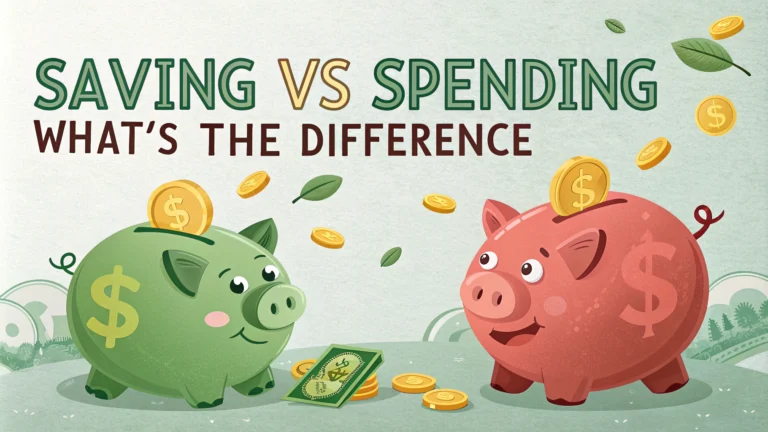Understanding the difference between saving and spending helps build strong financial habits. Money management skills directly impact your financial future and quality of life.
Creating a balance between saving and spending can transform your financial health. This guide explores key strategies to help you make smarter money decisions.
Key Differences Between Saving and Spending
- Saving means setting money aside for future use or emergencies
- Spending involves using money for immediate needs or wants
- Savings build wealth over time through compound interest
- Spending addresses current needs but reduces available funds
Smart Saving Strategies
- Set up automatic transfers to savings accounts
- Follow the 50/30/20 rule: 50% needs, 30% wants, 20% savings
- Consider high-yield savings accounts
- Track savings progress using mobile apps
| Saving Type | Recommended Amount |
|---|---|
| Emergency Fund | 3-6 months of expenses |
| Retirement | 10-15% of income |
| Short-term Goals | 5-10% of income |
Essential Spending Guidelines
- Create a monthly budget for essential expenses
- Distinguish between needs vs. wants
- Use cash or debit cards to avoid debt
- Track expenses using budgeting tools
> “The art of saving is the art of getting ahead.” – Scottish Proverb
Finding Balance: Save vs Spend Wisely
Building strong money habits requires understanding when to save and when to spend. Successful personal finance depends on making smart choices about every dollar.
Common Money Management Mistakes
- Not having a clear spending plan
- Ignoring small expenses that add up
- Using credit cards for everyday purchases
- Failing to maintain an emergency fund
Smart Tools for Money Management
| Tool Type | Benefits |
|---|---|
| Budgeting Apps | Track spending, set goals, get alerts |
| Bank Automation | Schedule transfers, pay bills on time |
| Investment Platforms | Grow wealth, monitor performance |
Resources for Financial Education
- Online courses from reputable financial institutions
- Personal finance books by certified experts
- Free workshops at local banks
- Government financial literacy programs
Taking Action Today
Start with small steps that lead to lasting financial habits:
- Review your current spending patterns
- Set up automatic savings transfers
- Create a realistic budget
- Choose one financial tool to master
> “Do not save what is left after spending, but spend what is left after saving.” – Warren Buffett
Remember that financial success comes from consistent good habits rather than dramatic changes. Start with one improvement at a time and build from there.
Quick Tips for Success
- Review your progress weekly
- Adjust your plan as needed
- Celebrate small wins
- Keep learning about money management
Focus on building sustainable habits that work for your lifestyle and income level. Small improvements add up to significant changes over time.
Frequently Asked Questions About Saving vs Spending
What is the fundamental difference between saving and spending money?
Saving means setting aside money for future use, while spending involves using money to purchase goods or services for immediate consumption.
How much of my monthly income should I save?
Financial experts recommend following the 50/30/20 rule:
- 50% for essential expenses
- 30% for discretionary spending
- 20% for savings and investments
What are the best ways to balance saving and spending in your 20s?
Key strategies include:
- Building an emergency fund
- Starting retirement contributions early
- Following a budget
- Avoiding unnecessary debt
- Living below your means
Does saving money mean I can’t enjoy life?
No. Smart saving involves finding a balance between current enjoyment and future security. Consider using methods like:
- Setting specific savings goals
- Using automatic transfers
- Finding free or low-cost activities
What are high-priority savings categories vs discretionary spending?
High-priority savings:
- Emergency fund
- Retirement accounts
- Debt repayment
Discretionary spending:
- Entertainment
- Dining out
- Non-essential shopping
How can I save money while living paycheck to paycheck?
Strategic approaches include:
- Track every expense
- Cut unnecessary subscriptions
- Start with small savings amounts
- Look for additional income sources
- Use cash-back apps and rewards
What’s the difference between good spending and bad spending?
Good spending includes:
- Investments in education
- Essential maintenance
- Health-related expenses
Bad spending includes:
- Impulse purchases
- High-interest debt accumulation
- Unnecessary luxury items
Should I save money or pay off debt first?
Consider this approach:
- Build a small emergency fund first ($1,000)
- Pay off high-interest debt (over 10%)
- Build full emergency savings
- Continue debt payoff while saving
What are the best apps for tracking saving vs spending?
Popular financial tracking apps include:
- Mint
- YNAB (You Need A Budget)
- Personal Capital
- PocketGuard
How do I create a realistic budget that balances saving and spending?
Follow these steps:
- Calculate total monthly income
- List all fixed expenses
- Set specific savings goals
- Allocate remaining funds for variable expenses
- Review and adjust monthly



















